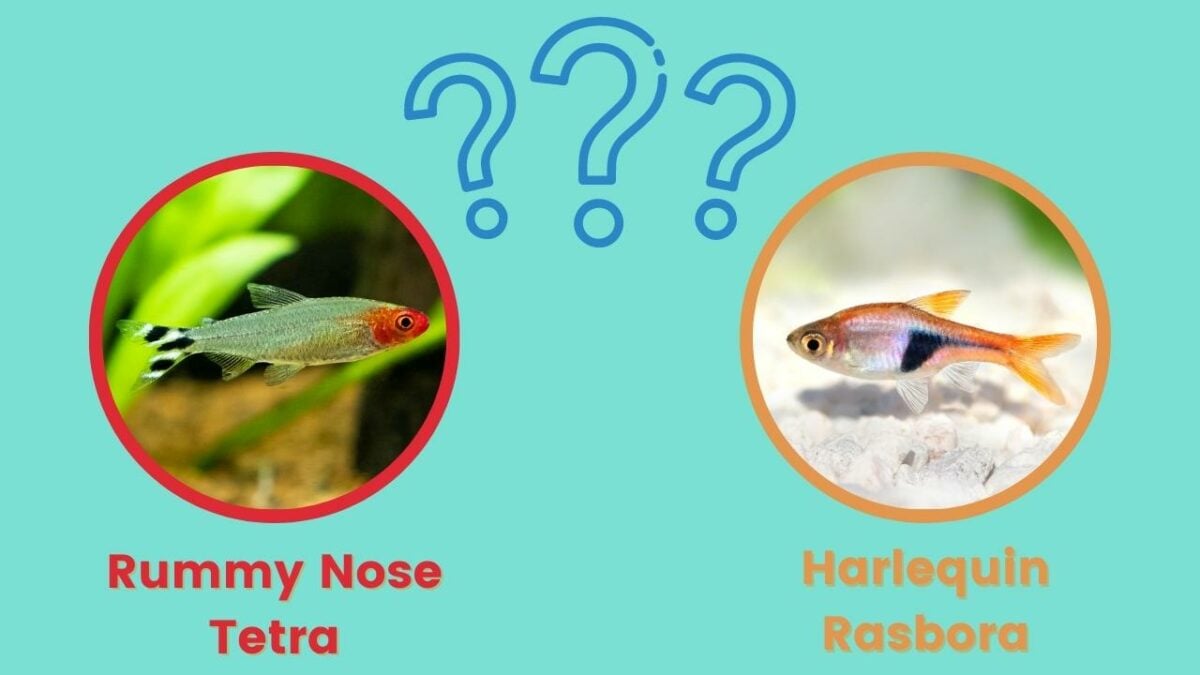
If you can’t decide between rummy nose tetra or harlequin rasbora for your tank, I’ll provide you with detailed information about both fish to help you pick the one that’s going to be the best fit for your aquarium.
Rummy Nose Tetra or Harlequin Rasbora Overview
Appearance
Rummy Nose Tetra (Hemigrammus rhodostomus) showcase a distinctive appearance due to their beautiful vibrant red-colored heads, which makes them stand out compared to other fish. Their bodies are mainly silver with a black and white striped tail.
Harlequin Rasbora (Rasbora heteromorpha) have a more uniform appearance, boasting a lovely copper-toned body with a distinct black triangular patch.
Size

Both Rummy Nose Tetras and Harlequin Rasboras are relatively small fish. Rummy Nose Tetras grow up to 2 inches in length, while Harlequin Rasboras can reach 1.5 inches.
Their small size makes them popular choices for community tanks and aquarists with limited space or if you have a large tank and want a large schooling group.
Habitat
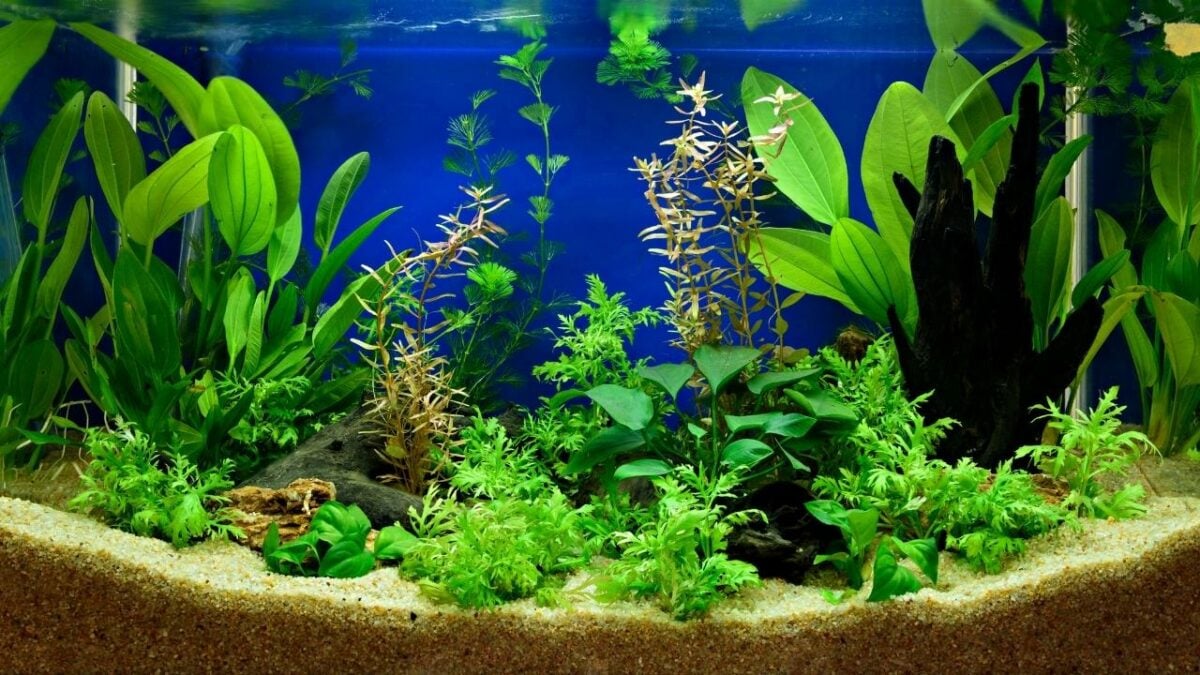
Native to South America, Rummy Nose Tetras prefer slow-moving waters, typically found in the Amazon basin. They thrive in water temperatures between 76°F-82°F (24.5°C-27.5°C) and enjoy a pH range of 6.0 to 7.0. They prefer softer water of around 3-8 dGH.
Harlequin Rasboras are native to Southeast Asia and can be found in densely vegetated areas. They thrive in water temperatures between 74°F-80°F (23.5°C-26.5°C) and can live in a pH range of 6.0 to 8.0. They prefer water on the softer side but can adapt to a wider range than rummies of around 2-12 dGH.
Both fish species appreciate a planted aquarium that mimics their natural habitat.
Lifespan
Typically, Rummy Nose Tetras have a lifespan of around 5 years when properly cared for in a suitable environment.
Harlequin Rasboras are known for their slightly longer lifespans, averaging between 5 and 7 years.
However, remember that providing quality water conditions, a well-maintained tank, and a balanced diet contribute to their longevity.
Tank Requirements
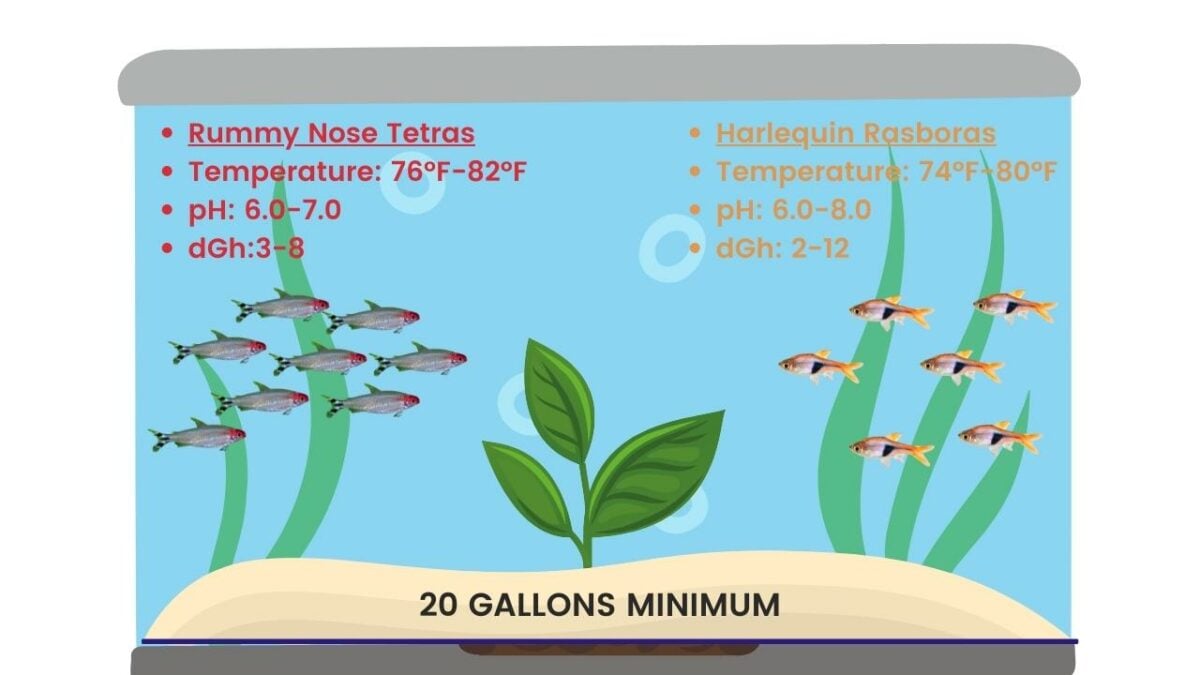
When it comes to creating the perfect environment for rummy nose tetras or harlequin rasboras, understanding their specific tank requirements is crucial.
This section will discuss the essential factors to consider, including the tank size, substrate, water parameters, and plants and decorations so that you have the ideal setup.
Tank Size
Rummy nose tetras and harlequin rasboras are schooling fish, so it’s essential to provide them with adequate space to swim together.
For these fish, a 20 gallon tank is the minimum size I recommended, but as always the more space you can give them the better.
You could get away with a 10 gallon tank for a group of 6 rasboras if you don’t want to keep anything else in with them, but for them to really thrive, they would prefer to be kept in a larger group/tank.
Substrate
Neither of these fish is particularly fussy about what substrate you choose, as they both tend to stay at mid-level in the aquarium.
I’d choose dark sand or gravel as it really makes their colors pop and stand out and it’s easy to keep clean.
Water Parameters
To ensure the well-being of rummy nose tetras and harlequin rasboras, it’s crucial to maintain specific water parameters.
Rummy nose tetras are definitely more sensitive and fussy about their water conditions, they thrive in water temperatures of 76°F-82°F (24.5°C-27.5°C) and a pH range of 6.0 to 7.0. They prefer softer water of around 3-8 dGh.
Harlequin rasboras are hardier and can adapt to a wider range of water parameters. They thrive in water temperatures between 74°F-80°F (23.5°C-26.5°C) and can live in a pH range of 6.0 to 8.0. They prefer water on the softer side but can adapt to a wider range of around 2-12 dGH.
Both of these fish prefer a lower pH range (slightly acidic water), so you could add some Indian almond leaves to help lower the pH in your aquarium if it’s a little high.
Plants and Decorations
Incorporating plants and decorations into your aquarium can enhance the fish’s comfort and well-being.
Rummy nose tetras and harlequin rasboras appreciate a planted tank with plenty of greenery, such as Amazon sword, Java fern, and Anubias, which help mimic their natural habitat and provide hiding spots.
Adding driftwood or other natural decorations can create an engaging environment for these fish to explore. Just ensure that all decorations are smooth and free of sharp edges to prevent injury to your fish.
Diet and Feeding
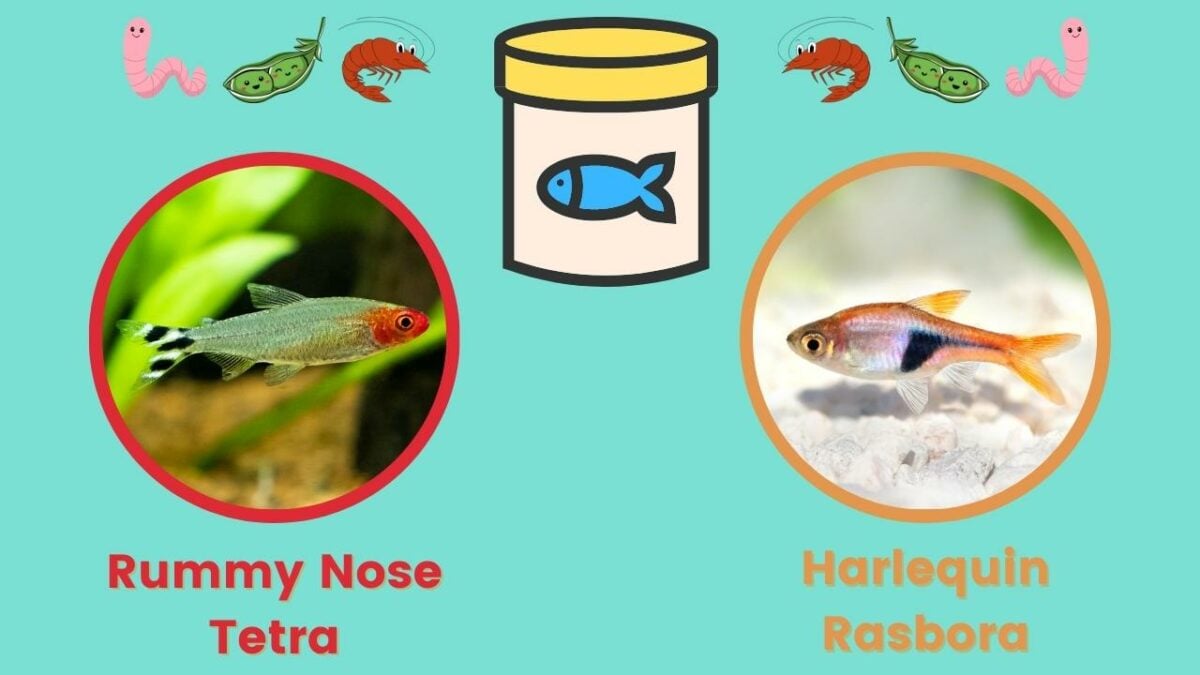
Both rummy nose tetras and harlequin rasboras are omnivores, meaning they consume a mixture of plant-based and animal-based food sources in their natural habitat.
To keep these fish healthy, it’s important to provide them with a balanced diet that includes a variety of foods.
- Pellet or flakes: High-quality flakes of pellets should be a staple part of their diet, providing essential nutrients.
- Live or Frozen: Brine shrimp and bloodworms should be fed occasionally to supplement their diet and encourage natural foraging behavior.
- Veg: Shelled boiled peas or blanched spinach offer nutrients and variety.
Feeding a combination of both live and prepared foods can help to ensure they get a diverse and nutrient-rich diet, promoting good health and vibrant colors.
Feed small amounts a couple of times per day and only enough food that can be consumed within a few minutes. If there’s any food leftover, reduce the amount you give them as this will help to keep the tank clean.
Behavior and Social Aspects
Schooling

In the wild, these fish form large groups to protect themselves from predators, making them ideal community tank inhabitants.
Rummy Nose Tetras are famous for their tight schooling behavior, often swimming in a coordinated, synchronized fashion, which makes a great eye-catching display in your aquarium. A minimum of 8 fish is recommended.
Harlequin Rasboras tend to form looser groups, with each individual maintaining a bit more freedom. A minimum of 6 fish is recommended.
Tank Mates
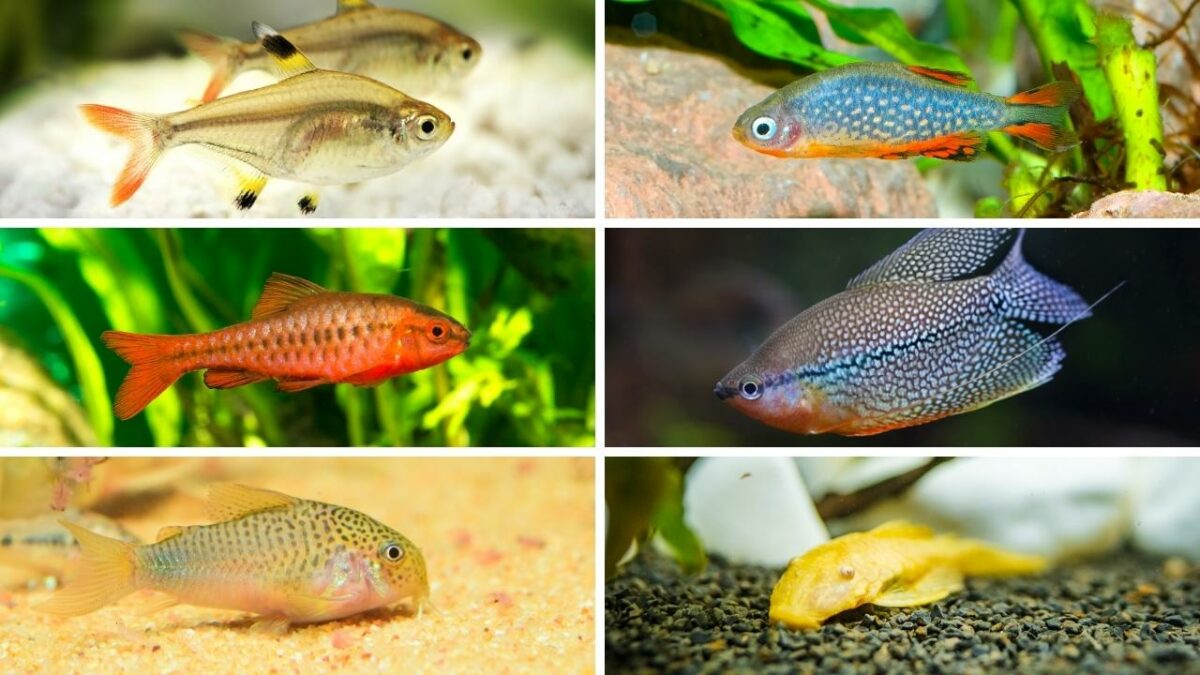
When it comes to selecting tank mates for these peaceful fish, compatibility is a crucial factor to consider.
Rummy Nose Tetras and Harlequin Rasboras are peaceful species and a great choice for community aquariums, they do best with other fish that share similar characteristics and require comparable water parameters.
Choose fish that are similar in size so that they don’t end up becoming a snack!
Suitable Rummy Nose Tetra & Harlequin Rasbora Tankmates:
- Amber Tetras
- Angelfish
- Apistogramma
- Betta Fish (dependant on bettas personality!)
- Bristlenose Pleco
- Cardinal Tetras
- Cherry Barbs
- Chili Rasbora
- Clown Pleco
- Corydoras
- Dwarf Neon Rainbow Fish
- Galaxy Rasbora
- German Blue Rams
- Gold Tetras
- Green Kubotai Rasboras
- Honey Gourami
- Kuhli Loach
- Neon Tetras
- Pearl Gourami
This isn’t an exhaustive list by any means, I’ve focused on picking popular options that are easy to get hold of at your local pet store, online, or from breeders.
I’ve included Betta Fish, but this really depends on your betta’s personality, if he is feisty and grumpy, leave him on his own! Some bettas are chilled and will live with rummies or harlequins if the tank is large enough (20 gal minimum.).
Health and Disease

When deciding between rummy nose tetra or harlequin rasbora for your aquarium, it’s essential to know about their health issues and how best to prevent and resolve them.
Harlequin rasboras are the hardier fish of the two, but they can still be susceptible to various diseases.
Common Diseases
The rummy nose tetra and harlequin rasbora can be plagued by several illnesses, including:
- Bacterial infections: Both species can experience bacterial infections, such as fin rot and bacterial gill disease. These may appear as ragged, discolored fins, or difficulty breathing in more severe cases.
- Parasites: Apart from Ich, other parasites such as flukes and worms can also infect these fish. They may exhibit signs of distress, itching, and slimy skin.
Some symptoms of common diseases to look out for are:
- Dropsy: Caused by stress, resulting in a swollen belly and pineconing (scales protruding).
- Fin rot: Often caused by bacterial infections, it results in the deterioration and loss of fin tissues.
- Ich: A parasitic infection resulting in small, white spots on the skin and gills.
- Popeye: One or both eyes will be protruding or bulging outwards.
- Swim Bladder Disease: Affecting the fish’s ability to swim properly, possibly due to poor water quality or nutrition.
- Velvet: A parasitic infection leading to a gold or rust-colored dusting on the fish’s body.
Prevention
High-quality water conditions and low stress contribute to the overall health of your fish. To minimize the risk of diseases, follow the following guidelines:
- Water Quality: Ensure the water parameters are within the suitable range for these fish. Maintain stable temperatures, pH levels, and conduct regular water changes to keep the environment clean.
- Filter: Use an adequate filtration system in your aquarium to remove debris and maintain good water quality. I use the Fluval 07 series canister filters.
- Feeding: Offer a varied diet of high-quality and nutritionally rich foods. A well-fed fish with good nutrition is more resistant to diseases.
- Quarantine: Quarantine new fish, live plants, and decorations for around 2-4 weeks before adding them to your established tank. This helps prevent introducing new pathogens into your aquarium.
Treatment
If a disease does strike your rummy nose tetras or harlequin rasboras, early diagnosis and treatment are crucial. Here are some steps to follow:
- Isolate the affected fish from the main tank to prevent the spread of diseases.
- Identify the illness and research appropriate treatments, such as antiparasitic, antibacterial, or antifungal medications.
- Follow the instructions on the medicine and adjust the dosage as needed.
- Monitor the progress and health of the affected fish during treatment.
- After successful treatment and recovery, reintroduce the fish to the main tank, ensuring proper re-acclimatization.
I’ve done some in-depth treatment guides for some of the most common diseases including, ich, dropsy, swim bladder, and popeye, should you need to treat your fish.
Choosing the Right Fish
When it comes to selecting the right fish for a freshwater aquarium, especially for beginners, it is essential to consider species that are easy to care for.
Harlequin Rasboras are without a doubt the hardiest of the 2 as they are able to adapt to a wider range of water parameters.
If you have a bit more experience under your belt, rummies make a great addition to an aquarium, especially if you have a large group of them so they can show off their eye-catching synchronized schooling behavior.
Rummy Nose Tetras For Beginners
These are great fish, but I wouldn’t recommend them to fishkeeping newbies. They require very stable and specific water requirements which can be difficult to maintain when you first start out in this hobby.
It’s essential that you fully cycle your tank before adding any rummy nose tetras and buy at least 8 of them for them to be happy and thrive.
A couple of things to note when buying these from the pet store, make sure their head is a vibrant red color, this shows they are healthy and not stressed.
Also, these guys love to ‘play dead’ once they are bagged up and ready for the journey home, so don’t worry if they suddenly start floating around upside down!
Harlequin Rasboras For Beginners
Harlequins are an excellent choice for beginners due to their hardiness and ability to adapt to different water conditions.
They do need to be kept in a group of at least 6 for them to be happy and thrive and they are a great option for community tanks due to their peaceful nature.
Frequently Asked Questions
How can you differentiate between male and female Rummy Nose Tetras and Harlequin Rasboras?
Identifying the sex of Rummy Nose Tetras and Harlequin Rasboras can be a bit challenging for beginners.
In general, female Rummy Nose Tetras have a slightly larger and rounder body compared to their male counterparts. Male Rummy Nose Tetras may also exhibit a slightly more vibrant red color on their nose.
In the case of Harlequin Rasboras, males tend to have a more intense color. The females, on the other hand, are usually larger and have a rounder belly.
What tank mates are suitable for Rummy Nose Tetras and Harlequin Rasboras?
Both Rummy Nose Tetras and Harlequin Rasboras are peaceful fish species, which makes them great companions in a community tank.
Suitable tank mates for these fish include other small and non-aggressive fish such as neon tetras, cardinal tetras, corydoras catfish, and small gouramis. See the list above for more ideas.
It is essential to avoid aggressive or larger fish as they may terrorize the tetras and rasboras, causing stress and possible death.
What are the breeding behaviors of Rummy Nose Tetras and Harlequin Rasboras?
Male Rummy Nose Tetras will chase the females to encourage spawning. The female Rummy Nose Tetras will scatter their eggs, so provide a breeding mop to catch the eggs.
Harlequin Rasboras utilize a unique method of egg laying where the female will turn upside down and attach her eggs to the underside of a broad leaf plant and the male will then fertilize the eggs.
Is it easier to maintain a Rummy Nose Tetra tank or a Harlequin Rasbora tank?
Harlequin Rasboras are definitely the easier of the 2, due to them being able to adapt to a wider range of water parameters.
Rummies need pristine water, are sensitive to ammonia, and have a narrower range of required temperature, pH, and water hardness for them to thrive.
Conclusion: Should You Choose Rummy Nose Tetras or Harlequin Rasboras For Your Aquarium?
Still can’t decide between the two…?
If you are a beginner I definitely lean towards you choosing harlequin rasboras as they are super hardy, peaceful fish.
If you have a little more experience, rummy noses look great in a large group exhibiting their tight, synchronized schooling behavior.
Check out the aquarium health section for guides on how to keep your aquarium in tip-top shape.
Related Article:

